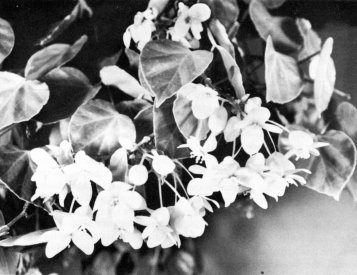Begonia solananthera was discovered in the Organ Mountains of Brazil. This species was originally described by Alphonse DeCandolle in 1859 in “Memoire sur la Famille des Begoniacees,” Annales des Naturelles, Series 4, Botanique II page 128. Later, in 1864, a more detailed description by Alphonse De Candolle appeared in Prodromus Systematis Naturalis Regni Vegetabilis.
B. solananthera is a beautiful trailing plant. The glabrous, medium green leaves are ovate with acute or cuspidate apices and obtuse bases. Leaves are small, averaging under 3″. This plant branches fairly readily producing a full plant. The beautiful fragrant flowers are white with crimson centers. The inflorescences are many-flowered and blooming is profuse during the winter months.
The botanical classification places B. solananthera in the section Solananthera of the genus Begonia of the family BEGONEACEAE. All species presently placed in this section are originally from Brazil.
The horticultural classification in The Thompson Begonia Guide for B. solananthera is “trailing- scandent, species.” There are about forty-five species and hybrids of Begonia in this horticultural grouping. Begonias are placed in this grouping because they will either trail or climb, and, in many cases, begonias in this group will do either according to their environment. Most begonias in this horticultural classification have similar cultural requirements.
B. solananthera is an excellent plant for growing suspended in a basket. We prefer to grow this species and most other trailing begonias in a moss-lined wire container because in these containers there is excellent drainage, and the porosity allows perfect aeration of the root system. During the summer months it is best to grow this Begonia in a semi-shady location because too much sun will quickly cause uncharacteristically pale foliage. Watering should be done carefully; be certain that the plant is always kept slightly moist but never soggy-wet. For a full plant it is essential to pinch new shoots continuously throughout the life of the plant. Old woody stems should be removed to allow new growth to take over. As with most other begonias, fertilizing must be done regularly with a complete fertilizer. A properly fed plant will be full, beautiful and resistant to disease.
B. solananthera is an outstandingly beautiful species for the suspended area of the indoor and outdoor garden. This lovely Begonia will richly reward the grower for his care.
Carrie Karegeannes, Annadale, Virginia, has very graciously given permission to print her translation of the Latin description of B. solananthera A. DC. as it appears in Prodromus:
105. B. solananthera (Alph. DC., Annales Sciences Naturelles, Botanique, Ser. 4, Vol. 9 {1859}, p. 128), half-shrub, rooting below, subscandent; branches glabrous; leaves ovately acute or cuspidate, palmately 6-veined, obtuse at the base, wavy-dentate, here and there angled or else entire, membranous, glabrous above, underneath chiefly on the nerves fulvo-pubescent (tawny-hairy); Stipules oblong, acuminate, falling off early, glabrous. Pedancles shortened, often dichotomous (forked), tawny-hairy; bracts ovate, ample, membranous, glabrous, falling off early. Male flowers with sepals {2 outer sepals} amply ovate; petals {2 inner sepals} obovately oblong, somewhat shorter than the sepals. Female flowers with lobes elliptic. Capsule not seen.
Woody. In the forest of the Organ Mountains of Brazil (Lhotsky! 135, in part), at Mandioca (Riedel! & Langsdorf 532 in the Lenningrad Herbarium), in Sierra Estrella (Wedd.! in the Paris Herbarium).
It appears parasitical, falsely. It grows to 1/2 to 1 foot tall. Branches at length glabrous. Leaves 2 to 3 inches long, 11/2 to 3 inches wide, with a petiole of 1 to 2 inches, the blade scarcely unequalsided, with principal subcentral vein sending out 2 veins from the middle on both sides. Stipules 1/2 to 2/3 inch long, 1/6 to 1/3 inch wide. Cymes quasi-terminal, 5- to 1 0-flowered, scarcely longer than the leaves. Bracts 2/3 to not quite 1/2 (i.e., 5/12) inch long. Flowers pink? Male sepals 1/2 inch long, 5/12 inch wide. Petals 5/12 inch long, 1/12 to 1/6 inch wide. Anthers 1/6 inch long, with tips truncate, inflexed-hooded, with dehiscent pores borne under the hood in the mode of the Solanum (the Nightshade). Female lobes {sepals} 5/12 inch long. Ovary 3-winged, very slender, minutely pubescent (minutely downy) dusty (powdered).


